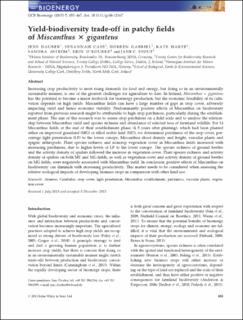Yield-biodiversity trade-off in patchy fields of Miscanthus × giganteus
Dauber, Jens; Cass, Susannah; Gabriel, Doreen; Harte, Kate; Åström, Sandra Charlotte Helene; O'Rourke, Erin; Stout, Jane C.
Peer reviewed, Journal article
Published version

Åpne
Permanent lenke
https://hdl.handle.net/11250/3084953Utgivelsesdato
2015Metadata
Vis full innførselSamlinger
- Publikasjoner fra CRIStin - NINA [2364]
- Scientific publications [1392]
Sammendrag
Increasing crop productivity to meet rising demands for food and energy, but doing so in an environmentally sustainable manner, is one of the greatest challenges for agriculture to date. In Ireland, Miscanthus 9 giganteus has the potential to become a major feedstock for bioenergy production, but the economic feasibility of its cultivation depends on high yields. Miscanthus fields can have a large number of gaps in crop cover, adversely impacting yield and hence economic viability. Predominantly positive effects of Miscanthus on biodiversity reported from previous research might be attributable to high crop patchiness, particularly during the establishment phase. The aim of this research was to assess crop patchiness on a field scale and to analyse the relationship between Miscanthus yield and species richness and abundance of selected taxa of farmland wildlife. For 14 Miscanthus fields at the end of their establishment phase (4–5 years after planting), which had been planted either on improved grassland (MG) or tilled arable land (MT), we determined patchiness of the crop cover, percentage light penetration (LP) to the lower canopy, Miscanthus shoot density and height, vascular plants and epigeic arthropods. Plant species richness and noncrop vegetation cover in Miscanthus fields increased with increasing patchiness, due to higher levels of LP to the lower canopy. The species richness of ground beetles and the activity density of spiders followed the increase in vegetation cover. Plant species richness and activity density of spiders on both MT and MG fields, as well as vegetation cover and activity density of ground beetles on MG fields, were negatively associated with Miscanthus yield. In conclusion, positive effects of Miscanthus on biodiversity can diminish with increasing productivity. This matter needs to be considered when assessing the relative ecological impacts of developing biomass crops in comparison with other land use. Keywords: Araneae, Carabidae, crop cover, light penetration, Miscanthus establishment, patchiness, vascular plants, vegetation cover Yield-biodiversity trade-off in patchy fields of Miscanthus × giganteus
